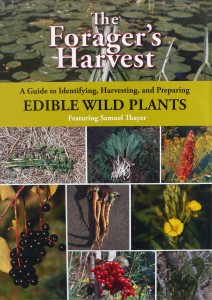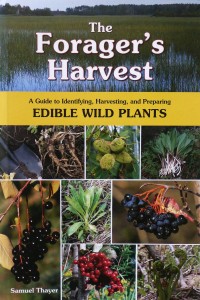Teaching experience: Over 25 years
Primary region: Great Lakes, Midwest, Northeast, southern part of Eastern Canada (The Forager’s Harvest) and North America (Nature’s Garden)
Website
Website: Forager’s Harvest
Website pages include articles and excerpts, wild rice and maple syrup sales info, reviews of related books and field guides, resources and links (including events, wild food instructors, organizations and blogs) and an online store for the following books and DVD.
Books
The Forager’s Harvest
Written by Samuel Thayer
Copyright 2006
Published by Forager’s Harvest
- Introduction
- The Meaning of Wild Food
- The Purpose and Organization of this Book
- The History of Foraging and Wild Food Literature
- Getting Started With Edible Wild Plants
- Why Forage?
- Conservation
- Where to Forage
- Cooking With Wild Food
- Plant Identification and Foraging Safety
- Harvest and Preparation Methods for Wild Plant Foods
- Greens
- Shoots and Stalks
- Underground Vegetables
- Fruits and Berries
- Seeds and Grains
- Nuts
- Storing Wild Foods
- Freezing
- Canning
- Drying
- Cold storage
- Seeds and Grains
- Nuts
- Timing the Wild Harvest
- Calendar
- Plant Accounts
- Ostrich Fern
- Cattail
- Wapato, Arrowhead
- Wild Rice
- Wild Leek, Ramp
- Smilax, Carrion Flower
- Butternut
- Siberian Elm
- Stinging Nettle
- Wood Nettle
- Sheep Sorrel
- Goosefoot, Lamb’s Quarters
- Spring Beauty
- Marsh Marigold, Cowslip
- Swamp Saxifrage
- Serviceberry, Juneberry, Saskatoon
- Chokecherry
- Pin Cherry
- Ground Bean, Hog Peanut
- Hopniss, Groundnut
- Black Locust
- Sumac
- Wild Grape
- Basswood, Linden
- Evening Primrose
- Parsnip
- Common Milkweed
- Virginia Waterleaf
- Nannyberry, Wild Raisin, Black Haw
- Highbush Cranberry
- Burdock
- Thistle
Review: The care and detail shown in this book is remarkable. The beginning chapters are filled with practical advice derived from personal experience. After beginning each plant chapter with a (usually personal) story about the plant, Thayer methodically takes the reader through the process of identifying the featured plant as well as any “looks similar” plants. When discussing the range and habitat, Thayer will also bring in other species members of the genus for comparison. Numerous color photographs complement the featured plant’s description and document the identification, harvesting and food preparation process for the plant.
Available from: Forager’s Harvest website, bookstores and online bookstores.
Nature’s Garden
Written by Samuel Thayer
Copyright 2010
Published by Forager’s Harvest
- Nature’s Garden
- The Purpose of This Book
- The Plants and Region Covered by This Book
- A Note on Plant Names
- Getting Started With Edible Wild Plants
- Where to Forage
- Why Wild Food?
- Conservation
- Does Foraging Harm the Environment?
- Plant Identification and Safe Consumption
- Some Thoughts on Wild Food
- Don’t Make It Fit
- There Are No Instant Experts
- The Ethnographic Void
- What Is a Meristem and Why Should I Care?
- Poisonous Plant Fables
- One Month Eating Wild
- Timing the Wild Harvest
- Calendar
- Plant Accounts
- Trout Lily, Fawn Lily, Glacier Lily
- Solomon’s Seal
- False Solomon’s Seal, Solomon’s Plume
- American Lotus
- Mayapple
- Hackberry, Sugarberry
- Walnut, Black Walnut
- Acorn
- Hazelnut
- Prickly Pear, Nopal
- Amaranth, Pigweed, Water-Hemp
- Dock
- Maypop, Passion Flower, Apricot Vine
- Toothwort
- Garlic Mustard
- Blueberry, Huckleberry, Bilberry
- Cranberry, Lingonberry
- Black Huckleberry
- New Jersey Tea, Oregon Tea, Ceanothus
- Wild Strawberry
- Black Cherry
- Sandcherry
- Wild Plum
- Aronia, ChokeBBBBerry
- Autumnberry, Autumn-olive
- Bunchberry, Dwarf Cornel
- Wood Sorrel
- Honewort, Wild Chervil
- Wild Carrot
- Cow Parsnip
- Black Nightshade
- Bugleweed
- Elderberry
- Jerusalem-artichoke
- Ox-Eye Daisy
- The Lettuce-Dandelion Group
- Wild Lettuce
- Sow-thistle
- Prenanthes, White Lettuce
- Dandelion
- Chicory
- Salsify, Oyster Plant, Goat’s Beard
Review: Nature’s Garden continues in the same easy-to-read style as The Forager’s Harvest — with an expanded repertoire of edible plants. Thayer writes eloquently and passionately about these plants, how to identify them, and how to develop foraging skills.
Available from: Forager’s Harvest website, bookstores and online bookstores.
DVD
The Forager’s Harvest
By Brian Pierce
Copyright 2010
Published by Brian Pierce

Review: This two-disc DVD set covers the same 32 plants as Thayer’s first book (above). In each segment, Thayer clearly demonstrates the identifying characteristics of a plant, how and when to harvest it, and sometimes how to prepare the harvest for eating. The videos are an excellent complement to the book as they facilitate learning each plant and how to forage for it.
Available from: Brian Pierce via contact info (and Paypal account) on the Forager’s Harvest website.


